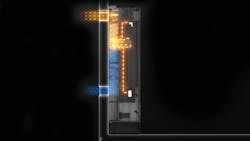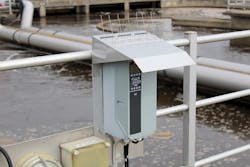Specifying variable frequency drives (VFDs) involves much more than simply knowing the horsepower of the motor. VFD technology has changed and improved over time, and specifications should be written with that in mind. There are many variables to consider, from where they will be mounted to how any electrical noise will be handled, and more. Below are 10 tips that should be kept in mind when specifying VFDs.
- VFD sizing should be based upon full load amperage (FLA). VFD sizing is based on FLA rather than on horsepower. Although motors from different manufacturers may have the same horsepower, they will have different FLA ratings. Motor overloads must also be considered. Variable torque applications, such as centrifugal pumps, usually have a 110 percent overload rating, while constant torque applications, such as positive displacement pumps, are generally 150 percent. Check the VFD data sheet for its overload rating as the drive may need to be derated depending on the application. A VFD is a current-producing device; horsepower is merely a guideline indicating the power of the current, and it is imperative that additional details be considered so that the VFD can produce the motor currents required by the specific application.
- Use a single-phase drive rather than derating a three-phase. Accepted practice has been to derate a three-phase drive in single-phase applications. This voids UL approval and can cause additional issues such as the drive not tripping when it should. There are manufacturers, including Danfoss, with drives specifically built for single-phase applications. These will be consciously designed for single-phase application and should therefore have UL approval.
- VFDs should contain an internal DC choke. AC line reactors require wall/panel space while also generating heat and higher losses. When using an AC line reactor, the equivalent voltage will be reduced to the drive. For example, a 3 percent line reactor will only allow the drive to receive 97 percent voltage. A DC choke will be internal to the drive and help ensure it is running at maximum efficiency, including ensuring the motor gets full voltage. Internal DC chokes will also provide a more stable supply voltage to the DC bus, resulting in better performance from the capacitors.
- Choose a warranty that covers more than the minimum. Industry standard warranty is around 18 months, but manufacturers usually offer extended warranty options. At a minimum, ensure that the warranty covers the time period beyond the date where construction is completed. For added protection, specify a warranty that covers lightning and other anomalies. Take advantage of manufacturers offering longer warranty options.
- Specify harmonic mitigation based upon analysis. IEEE 519 is seen as a necessity in many specifications. When specifying a VFD, IEEE mitigation will be required; however, depending upon the situation, IEEE could be unnecessary and result in higher project costs. Conduct a harmonics analysis based upon the electrical one-line diagram to determine whether mitigation is necessary. If it is, then specify IEEE 519 to ensure proper mitigation is being provided.
- Harmonic mitigation method should be chosen based upon application. There are many different methods of harmonic mitigation, and each has its own merits. Passive filters tend to be the best solution at lower power ratings, active filters are best at higher ratings, and active front end should be chosen when regeneration from the motor is possible. Rather than committing to a single mitigation method for all situations, make sure to design a specification based upon the individual application.
- Explore indoor mounting options. VFDs can be mounted practically anywhere. A motor control center (MCC) does not need to be the first option under consideration. There are multiple possibilities, including wall-mount, free standing, or panel mounting. When mounting outside of a panel or MCC, there is more flexibility in both cooling and dimensional sizing. Air conditioning and wall space are almost always at a premium in any facility. Back channel cooling is a unique option. This will allow flexibility in the cooling intake and exhaust with the option to be external to the building, thus greatly decreasing the air conditioning load of the room.
- Explore outdoor mounting options. There are VFD manufacturers that offer NEMA 4X and NEMA 3R options meant for outdoor mounting. Mounting outside handles many cooling and space issues that could require the construction of a new building in some situations. When mounting outdoors, make sure to provide a cover to protect the keypad screen, which may degrade under long-term direct sunlight.
- Specify a bypass in critical applications. When using drives in critical applications without redundancy, add a bypass so that the motors can still be run across the line. This will allow the motor to run across the line until repairs or replacement of the VFD can be completed. If at a higher horsepower, specify a soft-start bypass to limit the larger starting current.
- Choose a fused disconnect over a circuit breaker. Fuses will clear more quickly than a circuit breaker, thus minimizing the likelihood of catastrophic failure or injury. To achieve 100 kA short circuit current rating with a circuit breaker, manufacturers either must add an AC line reactor or increase the cabinet size, neither of which is efficient or cost effective. Fast-acting fuses will provide 100 kA without extra equipment.
When specifying VFDs, there are many different options and approaches to be considered. Following these guidelines will provide a good base for the specification. VFDs can be a big-ticket item on a project, so when specifying VFDs, being cost-effective and efficient is essential. Using these tips can open budgets for other expenditures while still improving the application. WW
About the Author: Edmund Post is a regional sales engineer – water segment for Danfoss Drives. He manages municipal water/wastewater sales for North Carolina, South Carolina, Tennessee, Kentucky, Indiana, and Southern Ohio. He has a B.S. in mechanical engineering from the University of Kansas.





